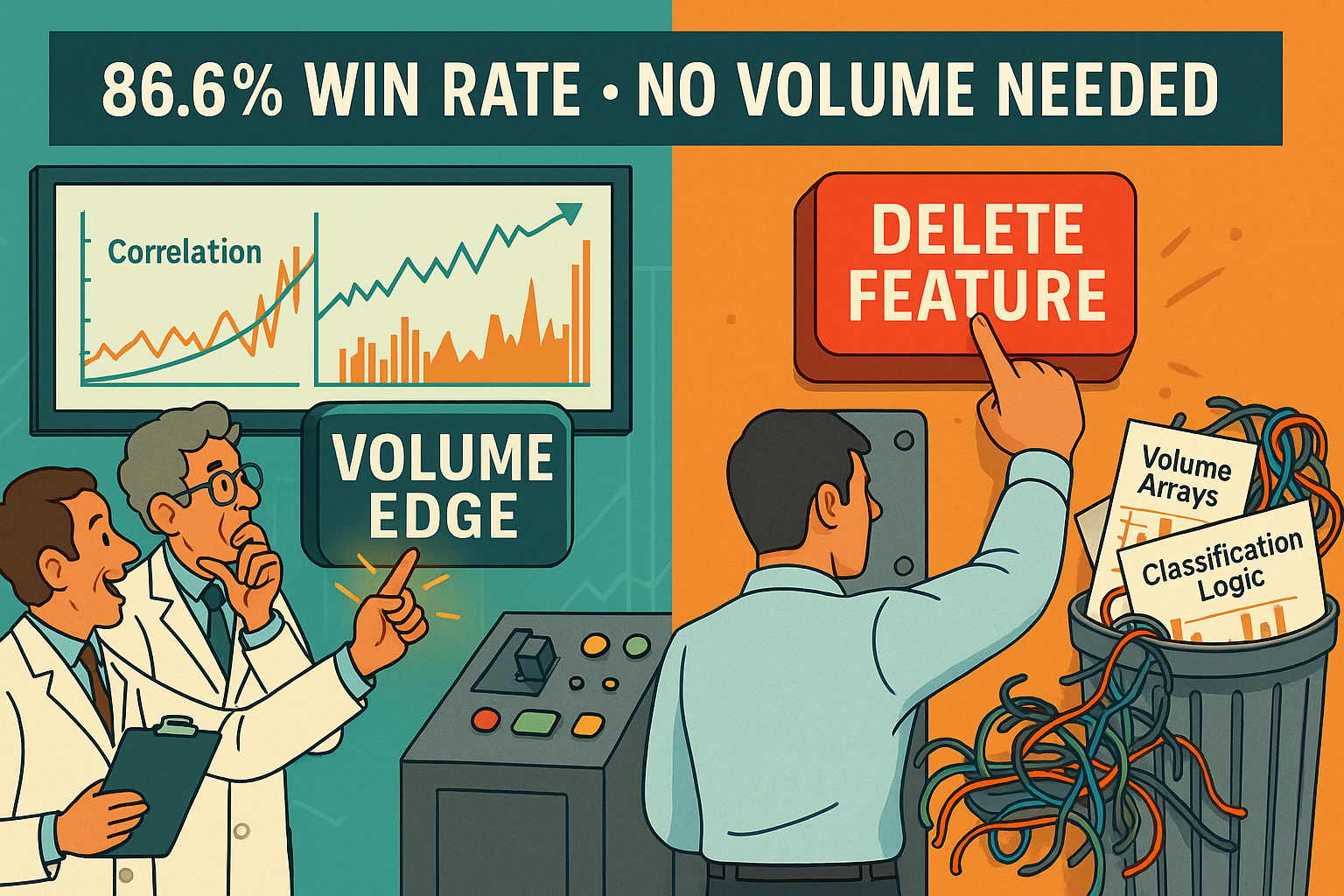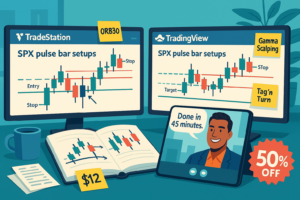A Case Study in Evidence-Based Trading System Development
 Ahoy there, Trader! ⚓️
Ahoy there, Trader! ⚓️
It’s Phil…
When Good Research Meets Hard Reality
We had a trading system with an 86.6% win rate.
Compelling research suggested opening volume analysis could push it even higher. Three development cycles and sophisticated statistical tracking later, we discovered the uncomfortable truth:
“Sometimes the best feature addition is feature subtraction.”
This is the story of building, testing, and ultimately discarding a theoretically sound enhancement that failed the only test that matters – improving actual trading outcomes. It’s a case study in why rigorous hypothesis testing beats feature enthusiasm, and how mature trading system development requires the discipline to kill your darlings when the data demands it.
The Hypothesis
The Premium Popper v1.5.7 already delivered exceptional results: 86.6% win rate on SPX Opening Range Breakout (ORB) trades using options-emulator logic. But compelling research from Edgeful suggested volume analysis could provide additional edge.
The theory was seductive: if the first 15 minutes of volume correlates 0.76 with rest-of-day volume, and high volume days produce cleaner directional moves, then filtering ORB trades by opening volume should improve an already strong system.
For options sellers, this held particular appeal. We don’t need sustained trends – just initial breakout integrity while time decay works in our favor. High volume days promised exactly that: better breakout follow-through without the whipsaw action that kills premium collection strategies.
Keep reading for a detailed breakdown of systems development.

Trade SPX Like a Machine. Get Paid Like a Boss.
Rule-based spreads. Defined risk. Cash-settled. Welcome to trader freedom.
The Implementation Journey
Stage 1: Basic Volume Classification (v1.5.8)
Added minimal volume tracking during the 9:30-9:45 AM window with simple threshold-based classification:
- High Volume: >120% of recent average
- Low Volume: <80% of recent average
- Normal Volume: 80-120%
Result: System worked but showed “No Data” for low volume days, suggesting our methodology was flawed.
Stage 2: Statistics Separation (v1.5.9)
Enhanced the system to track win rates separately by volume environment:
- Created volume-specific arrays for breakout results
- Added dedicated statistics rows showing performance by day type
- Maintained all existing functionality while building parallel tracking
Result: Clean data separation revealed the uncomfortable truth.
Stage 3: Methodology Correction
Discovered we were comparing opening volume to general intraday volume patterns rather than historical opening volume baselines – a fundamental error that invalidated our classifications.
Final Implementation: Built proper historical opening volume tracking to match the research methodology exactly.
The Verdict: Disappointing but Definitive
After implementing sophisticated volume analysis with proper statistical tracking, the results were unambiguous:
- High Volume Days: 91.2% win rate (52/57 days)
- Low Volume Days: 89.7% win rate (52/58 days)
- Difference: 1.5 percentage points
Why the Edge Didn’t Materialize
Research Translation Issues
The original Edgeful study focused on YM futures with clear volume correlation. SPX behaves differently:
- More consistent institutional flow
- Less dramatic volume variations
- Different market structure effects
False Precision Problem
We built a mathematically sophisticated system to capture an edge that doesn’t meaningfully exist in our target market. The 1.5% difference falls within statistical noise and provides no actionable trading advantage.
Strategy Mismatch
The research optimized for trend identification. Our options strategy only requires initial breakout integrity. These different objectives may explain why volume filtering provides minimal benefit for premium collection approaches.
Development Lessons Learned
What Went Right
- Methodical Testing: Systematic progression from basic implementation to statistical validation
- Base System Preservation: Never compromised the proven v1.5.7 functionality
- Evidence-Based Decisions: Let data guide conclusions rather than confirmation bias
What Went Wrong
- Assumption Cascade: Applied research from different market (YM) to different strategy (options) without sufficient skepticism
- Implementation First, Validation Second: Should have tested the core hypothesis with simpler methods before building complex infrastructure
- Sunk Cost Continuation: Continued development despite early warning signs (missing low volume data)
Technical Debt Accumulated
- Code Complexity: Added 100+ lines for minimal benefit
- Maintenance Burden: Volume arrays, classification logic, display management
- User Confusion: Additional settings that don’t improve outcomes
The Uncomfortable Truth
Sometimes the most valuable development outcome is proving a hypothesis wrong. The Premium Popper’s 86.6% win rate doesn’t need volume enhancement – it’s already operating at a level where marginal improvements provide diminishing returns.
The volume analysis served its purpose by definitively answering the question: “Can opening volume analysis improve ORB breakout success?” The answer is no, at least for SPX options strategies.
Strategic Decision: Feature Removal
Based on this evidence, the volume analysis components will be removed from the production Premium Popper, reverting to the clean, proven v1.5.7 foundation. This decision reflects:
Performance Priority
A 1.5% theoretical edge isn’t worth the complexity cost when the base system already delivers exceptional results.
User Experience
Simpler tools with clear value propositions outperform feature-rich systems that dilute focus from core functionality.
Maintenance Efficiency
Every feature requires ongoing support. Features that don’t materially improve outcomes become technical debt.

Future Applications
The volume analysis infrastructure isn’t wasted – it may prove valuable for:
- Different timeframes where volume patterns show stronger correlation
- Other instruments with clearer volume/volatility relationships
- Standalone research tools for market regime identification
- Volatility prediction rather than directional bias
Conclusion
This development cycle demonstrates mature trading system evolution. Rather than feature creep driven by theoretical possibilities, evidence-based decisions eliminate complexity that doesn’t serve the core mission.
The Premium Popper v1.5.7 remains the production standard – a clean, focused tool delivering 86.6% win rates without unnecessary complications. Sometimes the best feature addition is feature subtraction.
The volume analysis experiment succeeded by failing instructively. In systematic trading, proving what doesn’t work is as valuable as discovering what does.
This case study illustrates the importance of hypothesis validation in trading system development. Not every theoretical edge translates to practical advantage, and the discipline to remove features that don’t materially improve outcomes separates professional tools from amateur feature collections.
Happy trading,
Phil
Less Brain, More Gain
…and may your trades be smoother than a cashmere codpiece
p.s. There are 3 ways I can help you…
- Option 1: The SPX Income System Book (Just $12)
A complete guide to the system.
Written to be clear, concise, and immediately actionable.
>> Get the Book Here
- Option 2: Full Course + Software Access – 50% off for Regular Readers – Save $998.50
Includes the video walkthroughs, tools for TradeStation & TradingView, and everything I use daily. Plus 7 additional strategies
>> Get DIY Training & Software
- Option 3: Join the Fast Forward Mentorship – 50% off for Regular Readers – Save $3,000
>> Join the Fast Forward Mentorship – trade live, twice a week, with me and the crew. PLUS Monthly on-demand 1-2-1’s
No fluff. Just profits, pulse bars, and patterns that actually work.



